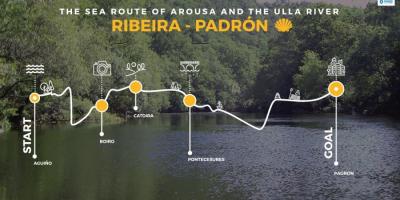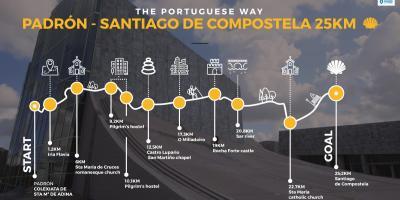Cualquiera entiende que el Camino de Santiago gira alrededor de la figura del Apóstol Santiago. Por eso de inicio, esta ruta tiene gran trascendencia dado el significado que supone la llegada del cadáver del Apóstol en una barca de piedra por la Ría de Arousa y el Río Ulla hasta Iria Flavia (Padrón). En la Iglesia de Santiago de Padrón se encuentra el pedrón con el que se cree que se amarró la barca. Se trata de una muestra más de la magia y singularidad que se percibe a lo largo de este itinerario, dado el haz de misterio y leyenda que rodea a la historia del Apóstol. No hay mejor modo de seguir los pasos de Atanasio y Teodoro cuando trasladaron sus restos.
Como se puede entender, esta ruta combina agua y tierra. En las localidades bañadas por la ría hay distintos puntos de sellado para los barcos que se acercan, tanto derivados del servicio turístico como el resto. Desde ellos, siguiendo un vía crucis fluvial, es fácil disfrutar de la belleza de las playas, el valor de numerosas construcciones históricas y la autenticidad de la actividad marinera. El itinerario terrestre, como se explicó antes, comienza en el municipio de Padrón: refugio de historia, de muestras patrimoniales relacionadas con ella y, también, de poetas. Podemos destacar atractivos concretos de los que podrá disfrutar el peregrino, como su maravilloso Jardín Botánico, la Iglesia de Santiago o los pimientos de la localidad. Por su parte, Iria Flavia, parroquia padronesa, tiene una amplia relevancia histórica puesto que fue incluso sede episcopal en la época de los visigodos. Destaca allí la Casa dos Coengos, procedente del siglo XVIII. Ya entre Rois y Teo, se puede disfrutar del maravilloso espacio natural que envuelve al Pazo do Faramello, lugar de la primera fábrica de papel de Galicia. Allí, destaca la excepcional biodiversidad, con ejemplares autóctonos especiales y dignos de ver.
En Ames, al llegar a las cercanías de O Milladoiro, el peregrino ya va notando de cerca el final del trayecto, por la evidencia de las vistas.
At the beginning of the route we have the Natural Park of the Dunas de Corrubedo e Lagoas de Carregal e Vixióan, a complex of 5 km of beaches and a unique ecosystem. The Lighthouse of Corrubedo of 1853 and the Island of Sálvora that belongs to the Natural Park of the Atlantic Islands make Ribeira a mandatory visit. There are also numerous megalithic monuments including the Dolmen de Axeitos with more than 4000 years of antiquity.
Already in A Pobra, the Torre de Xunqueiras from the 15th century, the Torre de Bermudez from the 16th and the Valle-Inclán Museum are three of the most important points to visit in this city hall. The viewpoint of the Curota is the highest point of the peninsula with 498 m. of altitude, from which it is possible to contemplate a unique panorama of the estuaries. In addition to the numerous coves and beaches, we can also refresh ourselves in any of the numerous natural pools in the Pedras river.
The Castro de Neixón from the 1st century is one of the main archaeological sites of the estuary. Located in the municipality of Boiro, this territory offers a great variety of megalithic monuments such as the A Laxe de las Cabras' petroglyphs and Pedra da Bouza, from the Bronze Age, or the megalithic necropolis of Amañecida, among others.
In Iria Flavia, we find the footprint on the road to the Camilo José Cela Foundation, located in the Casas dos Coengos, built at the end of the 18th century. In front of it, the collegiate church of Santa María de Iria. Contiguous to the collegiate church, we find the cemetery of Adina, which preserves a Suevi necropolis from the 5th century.
Further on, continuoing the way to Compostela, we can visit the Santuario da Escravitude from the 18th century.
We find in this path two ruins of great interest. On the one hand the legendary Castro Lupario, where the queen Lupa lived; and on the other hand the Castelo da Rocha Forte from the 15th century, destroyed during the revoltas irmandiñas.





